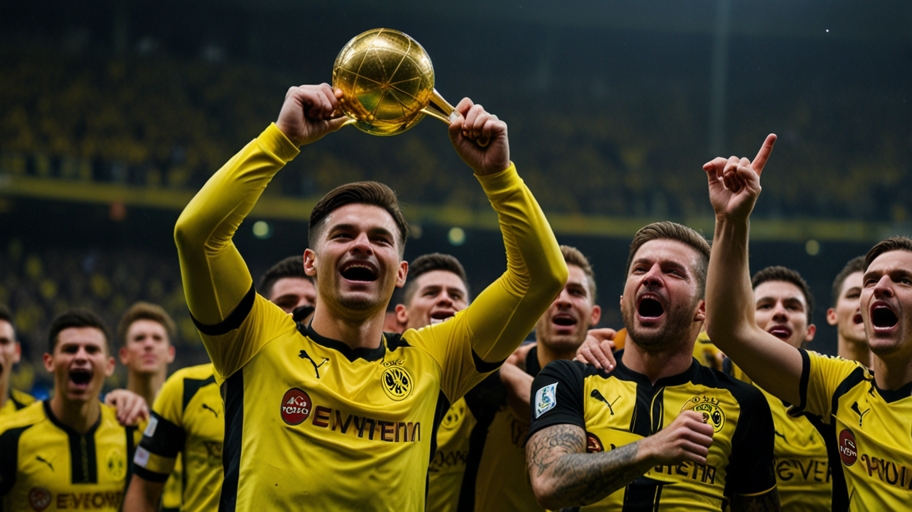Introduction
Borussia Dortmund, affectionately known as BVB, is a football club transcending the sport. With its unmistakable black-and-yellow colours, an electrifying approach to the game, and a fanbase that redefines loyalty, BVB stands as a titan in German and European football. It isn’t just another team—a movement, a symbol of grit, and a community celebration. This comprehensive guide explores BVB’s storied past, vibrant present, and promising future, delivering a fresh perspective on why this club captivates millions worldwide.
What Is BVB? Unpacking the Name and Identity
BVB stands for Ballspielverein Borussia 09 e.V. Dortmund, the official title of Borussia Dortmund, a club founded on December 19, 1909. The word “Borussia” nods to the Latin name for Prussia, tying BVB to its regional heritage in Dortmund, a city in Germany’s industrial Ruhr Valley. Known as “Die Schwarzgelben” (The Black and Yellows), BVB’s colours are more than a uniform—they’re a badge of honour worn by players and fans alike.
What makes BVB unique is its blend of tradition and ambition. While many clubs chase glory through big spending, BVB thrives on developing talent, fostering fan connection, and playing football that gets pulses racing. This identity has turned BVB into a global phenomenon, far beyond its Dortmund roots.

The Birth of BVB: A Rebel’s Beginning
BVB’s story starts with a spark of defiance. In 1909, a group of young men in Dortmund grew tired of the local Catholic Church’s grip on football activities. Meeting in a modest pub called Zum Wildschütz, they formed BVB as an act of independence. These founders, led by Franz Jacobi, envisioned a club that belonged to the people, not institutions—an ethos that still defines BVB today.
The early decades were about building a foundation. BVB competed in local leagues, steadily gaining traction. Their first taste of national success came in 1956 and 1957 when they won consecutive German championships. These triumphs signalled that BVB was ready to step onto a bigger stage.
BVB’s Rise to Glory: The Champions League Triumph
The 1990s marked BVB’s golden age. Under Ottmar Hitzfeld’s masterful leadership, BVB claimed the UEFA Champions League in 1997, defeating Juventus 3-1 in a memorable final. Karl-Heinz Riedle’s brace and Lars Ricken’s audacious long-range strike sealed the victory, etching BVB into football history. It wasn’t just a win—it was proof that BVB could rival Europe’s elite.
However, success brought challenges. By the early 2000s, financial mismanagement pushed BVB to collapse. The club’s survival hinged on restructuring and the unwavering support of its fans. This resilience is a hallmark of BVB, showing that their spirit is as strong as their play.
Jürgen Klopp’s Revolution: Redefining BVB
When Jürgen Klopp arrived in 2008, BVB was at a crossroads. With his infectious energy and tactical genius, Klopp turned BVB into a powerhouse. His “Gegenpressing” philosophy—high-intensity pressing to win back the ball—led BVB to Bundesliga titles in 2011 and 2012. Stars like Mario Götze, Mats Hummels, and Robert Lewandowski flourished, embodying BVB’s new era.
The 2012-13 Champions League final against Bayern Munich was a high point, even in defeat (2-1). Klopp’s BVB played with fearless abandon, leaving a blueprint that still influences the club. His tenure proved that BVB could compete with anyone; budget be damned.

The Yellow Wall: BVB’s Beating Heart
Picture this: 25,000 fans packed into the Südtribüne at Signal Iduna Park, waving flags, singing anthems, and turning the stadium into a cauldron of noise. It is the Yellow Wall, the soul of BVB. As Europe’s most enormous standing terrace, it’s a sight that intimidates opponents and inspires players.
The Yellow Wall isn’t just about volume—it’s about loyalty. BVB fans have weathered financial crises, title droughts, and heartbreak, yet their passion never wavers. The club reciprocates by keeping tickets affordable, ensuring Signal Iduna Park remains a fortress for the everyman, not the elite. This bond is what sets BVB apart.
BVB’s Epic Rivalries: Battles That Define the Club
Rivalries give football its edge, and BVB has two that burn bright. Der Klassiker pits BVB against Bayern Munich, a clash of David versus Goliath. While Bayern often dominates, BVB’s victories—like the 3-2 thriller in 2018—ignite Dortmund. These games are about more than points; they test BVB’s mettle.
Then there’s the Revierderby with Schalke 04, a feud steeped in Ruhr Valley pride. Matches like the 4-4 draw in 2017, where BVB clawed back from a 4-0 deficit, showcase the raw emotion of this rivalry. For BVB fans, beating Schalke is a badge of honour.
BVB’s Youth Pipeline: Crafting Tomorrow’s Stars
BVB’s knack for producing talent is legendary. The club’s academy has churned out players like Jadon Sancho, who dazzled before joining Manchester United, and Youssoufa Moukoko, a teenage prodigy breaking records. It isn’t chance—BVB’s scouting and coaching prioritize skill, speed, and smarts.
Erling Haaland’s 86 goals in 89 games for BVB before his 2022 move to Manchester City is a standout example. Now shining at Real Madrid, Jude Bellingham also honed his craft at BVB. The academy ensures BVB’s roster stays fresh, even as stars depart.
BVB Today: Ambition Meets Adversity
In the modern era, BVB remains a Bundesliga force. The 2022-23 season was a rollercoaster—BVB led the table on the final day but faltered, drawing 2-2 with Mainz as Bayern snatched the title. It stung but highlighted BVB’s potential under Edin Terzić, a Dortmund-born manager who bleeds black and yellow.
With veterans like Marco Reus and youngsters like Karim Adeyemi, BVB’s squad is balanced and hungry. Their flair-filled football and deep Champions League runs—like the 2024 quarter-finals—keep them relevant. BVB’s transfer model, buying low and selling high, keeps the books balanced too.
BVB’s Role in Dortmund and Beyond
In Dortmund, BVB is a lifeline. As coal and steel faded from the Ruhr, BVB became the city’s heartbeat, uniting generations. The club’s “Leuchte auf” foundation supports local kids and families, showing BVB’s commitment to its roots.
BVB’s global reach is vast. Fan clubs from Australia to Canada cheer for BVB, drawn by its underdog charm and attacking play. The club’s eco-friendly initiatives—like solar panels at Signal Iduna Park—also make BVB a leader off the pitch.
BVB vs. Europe’s Titans: How They Measure Up
Stack BVB against Real Madrid or PSG, and the budget gap is stark. Yet, BVB’s 1997 Champions League win and consistent European performances show they can hang with the best. Their secret? A system that maximizes youth, tactics, and fan power. BVB may not hoard trophies, but they win admiration.
Where Is BVB Headed? The Road Ahead
BVB’s future is tantalizing. Breaking Bayern’s Bundesliga stranglehold is the immediate goal, and they’re close with talents like Jamie Bynoe-Gittens. Another Champions League title isn’t out of reach, either. Off-field, BVB’s global tours and digital push are growing their brand while staying true to their values.
Conclusion: Why BVB Endures
BVB is gritty, thrilling, and honest football with a pulse. From its rebel origins to its modern ambitions, BVB blends history with hope. The Yellow Wall, youth stars, and epic battles make BVB a club that matters. Whether in Dortmund or dreaming of it, BVB invites you to feel the passion.
What’s your favourite BVB moment? Share below, and let’s keep the conversation going!
FAQs About BVB
What does BVB mean?
BVB is short for Ballspielverein Borussia 09 e.V. Dortmund, the full name of Borussia Dortmund, founded in 1909.
When did BVB win the Champions League?
BVB won the UEFA Champions League in 1997, defeating Juventus 3-1 in Munich.
Who are BVB’s top rivals?
BVB’s fiercest foes are Bayern Munich (Der Klassiker) and Schalke 04 (Revierderby).
What’s the Yellow Wall?
The Yellow Wall is the Südtribüne at Signal Iduna Park, where over 25,000 BVB fans create a legendary atmosphere.
Why does BVB excel at youth development?
BVB’s academy focuses on scouting and training, producing stars like Sancho and Haaland.
References
“Borussia Dortmund: A History.” UEFA.com. https://www.uefa.com/uefachampionsleague/clubs/52758–borussia-dortmund/
Honigstein, Raphael. Das Reboot: How German Football Reinvented Itself. Yellow Jersey Press, 2015.
“The Yellow Wall: A Footballing Phenomenon.” Bundesliga.com. https://www.bundesliga.com/en/bundesliga/news/yellow-wall-dortmund-signal-iduna-park-fans-culture-explained
“BVB’s Financial Recovery.” The Guardian. https://www.theguardian.com/football/2015/mar/11/borussia-dortmund-financial-recovery
“Sustainability at Signal Iduna Park.” BVB.de. https://www.bvb.de/eng/Club/Stadium/Sustainability



